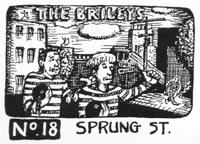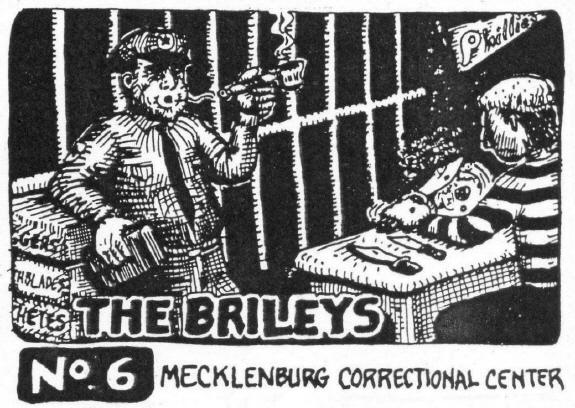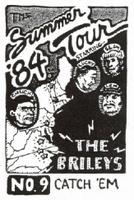Sunday, April 28, 2024
"Catch and Kill," Indeed
Saturday, April 20, 2024
Remembering Roy Scherer on April 20th
 |
| Roy B. Scherer (circa 2006) |
Longtime Virginia politicians, as well as veteran political reporters, were all familiar with Roy (pictured right, my photo) and his opinions, especially those opinions having to do with the legalization of marijuana. As he was Virginia's original registered lobbyist dedicated to that issue, it is particularly appropriate to remember Roy -- now, with a legal smile -- on April 20th.
SENATE RESOLUTION NO. 126Offered March 4, 2024
WHEREAS, Roy Britton Scherer, a passionate advocate for the legalization of marijuana and a beloved husband and friend to many in the Richmond community, died on December 8, 2023; and
WHEREAS, Roy Scherer was born in Richmond, attended military schools in his youth, and ultimately graduated from the Miller School of Albemarle; and
WHEREAS, Roy Scherer served the nation as a member of the United States Air Force, then volunteered with numerous organizations in the pursuit of social justice and civil rights; and
WHEREAS, Roy Scherer formed Virginians for the Study of Marijuana Laws and was at the forefront of advocacy for the legalization of marijuana in the Commonwealth; and
WHEREAS, from 1985 to the time of his passing, Roy Scherer worked for Virginians Against Drug Violence, cultivating strong working relationships with government agencies, nonprofit organizations, and stakeholders; and
WHEREAS, Roy Scherer impressed colleagues and state officials alike with his expertise, analytical mind, unwavering convictions, and persistence; and
WHEREAS, Roy Scherer was a longtime member and volunteer of the Libertarian Party of Virginia, and a fixture of the Richmond community who touched countless lives through his kindness and generosity; and
WHEREAS, Roy Scherer will be fondly remembered and greatly missed by his wife of 20 years, Sally; and numerous other family members and friends; now, therefore, be it
RESOLVED, That the Senate of Virginia hereby note with great sadness the loss of Roy Britton Scherer; and, be it
RESOLVED FURTHER, That the Clerk of the Senate prepare a copy of this resolution for presentation to the family of Roy Britton Scherer as an expression of the Senate of Virginia’s respect for his memory.
Thursday, April 18, 2024
Trump's Jailed Martyr Ploy
Hey now, reports out of Manhattan are saying, the judge thinks they have a jury seated for the Trump election-tampering case. Still, the reader may wonder, what about the damn trampled on gag order?
OK, it looks to me like Trump actually wants to spend a night, or two, a week at the most, in the hoosegow. Some safe form of jail. Let's say it's like being grounded in the special X-Presidents' Suite, perhaps somewhere in the courthouse ... with no telephone.
At this point, I expect data from a focus group has suggested to the Trump camp that the spectacle of jailing Trump, with him gushing perp-walk trash-talk, will goose the craziest elements of his base to take action, ASAP. Your guess is as good as mine what that might mean.
This Jailed Martyr Ploy episode, or something like it, would be a-made-to-order kick-off for Trump's election year campaign using anger and fear to motivate and direct his Brownshirt cells. Maybe to be totally Trumpy -- the shirt color should be goldenrod.
-- 30 --
Wednesday, April 17, 2024
Those Missing Briley Cards
Note: In June of 1984, Richmonders experienced an abrupt change in the way mainstream news was gathered and presented. A monster jailbreak story caused that to happen. Because of that change, I stumbled onto an offbeat gimmick in the world of self-publishing. This piece about that episode was first written in 1988 for publication in SLANT. For the online realm, I rewrote it in 2005.
While their four accomplices were rounded up quickly, the brothers Briley remained at large for 19 days. The FBI captured the duo at a picnic adjacent to the garage where they had found work in Philadelphia.
Linwood Briley was subsequently electrocuted in Richmond on Oct. 12, 1984; likewise, James Briley on Apr. 18, 1985.
While the Brileys were on the run the volume and intensity of the media coverage, both local and national, was unprecedented. During that manhunt the Brileys-mania that surrounded it led to stories about them being spotted, simultaneously, in various locations on the East Coast from North Carolina to Canada.
“OK,” I said to a familiar Power Corner Happy Hour group in the Texas-Wisconsin Border Cafe, “if the Briley brothers can be made into heroes, to sell tires and sofas on TV, how long will it be before they're on collectable cards, like baseball cards? (or words to that effect).” To illustrate my point I grabbed a couple of those Border logo-imprinted cardboard coasters from the bar and sketched quick examples on the backs, which got laughs.

Traveling around to Fan District bars on my bicycle, it took about three days to sell out the first press-run from my olive drab backpack. New cards were designed, to expand the set to 14 cards. More sets were printed, more plastic bags, more bubble gum.
Reporters started calling me for easy quotes, to fill articles on death penalty issues. That I was opposed to the death penalty seemed to strike some of them as odd. Finding myself in a position to goose a story that was lampooning the overkill presentation of the same press corps that was interviewing me was fun. At first.
Some of them, if not all, had box cutters in their hands; all of them were definitely Black. At that moment I felt Whiter than Ross Mackenzie (then the editorial page editor of the Richmond News Leader). Tension filled the air when their spokesman asked if I was the man behind those cards and T-shirts.
As it was not the first time I’d been subjected to questions about the cards, I promptly asked if any of them had seen the cards. Or, had they only heard about them?
So, I did. She gave me specific details. It was mostly stuff I had known, or suspected, but the way she told it was brutal.
At this point the success of my absurd art project seemed to be turning sour. Then I got a call from a reporter asking me what I had to say about Linwood Briley having made some disparaging remarks about my cards. Well, I got peeved and asked the scribe what the hell anybody ought to care about what such a man has to say.
Rea says he designed the cards to deflate what he saw as the growing mythology of the Brileys, and to lampoon what he viewed as excessive media attention to their exploits. "The cards are deliberately provocative," he said. "I sensed that the Brileys, because of their derring-do, were becoming heroes. People wanted to know everything about them. We had two to three articles in the paper every day down here."Rea drew the first cartoons for friends. When they found them amusing, he decided to market them at $1.50 a pack. "I'm a little uncomfortable that I'm becoming a part of the point I'm making," he said.
About three years later, I was having a beer in the Bamboo Cafe, standing at the bar at Happy Hour talking with friends. A middle-aged man who I didn’t know stepped my way. Furtively, he asked if I was the guy who “drew those Briley cards.”
 After I said, “yes,” and introduced myself, he asked me a few frequently asked questions about the cards. Then he spoke in a hushed tone, saying something like, “What about those missing cards?”
After I said, “yes,” and introduced myself, he asked me a few frequently asked questions about the cards. Then he spoke in a hushed tone, saying something like, “What about those missing cards?”“Missing cards?” I returned, feeling uncomfortable. “Are you asking why I skipped some numbers?
He nodded and reached in his shirt pocket to pull out a full set of The Brileys, with the cards still in the original plastic bag. Wanting to end the conversation quickly -- that he had the cards with him was way too strange for me -- I told him the simple truth with no jokes: “OK. First, I wanted to imply there was a vast series out there, without having to create it. Then, I wanted the viewer to maybe imagine for himself what the other cards might be.”
The collector put the cards back in his pocket. He stepped away, obviously disappointed with my easy answer, which gave him no dripping red meat to savor. As I remember it, he just walked away and didn't say anything else.
Saturday, April 13, 2024
What Did Not Happen
By the time my daughter, Katey, was in high school two decades later, the culture had changed quite a bit. By then exotic fire arms and a potpourri of mind-bending drugs had become widely available, surely available to anyone with much of a desire to possess them, including kids.
Speaking of attractive dangers for kids, one particular episode from my daughter’s high school years stands out as a time when something awful could have happened ... but didn't.
Anyway, a few blocks from the school’s downtown headquarters, there was a large, rather run down, warehouse-like building that was being rented out by-the-room as cheap housing, art studio space, and whatnot…
At this time, I was still somewhat plugged into the mid-town, artsy night life scene in town. So when colorful stories emanating from parties that had taken place in the aforementioned building began to circulate, they easily found their way to my ear. In that process, I found that my 15-year-old daughter had been seen at one of those parties.
The worrisome details of what she blurted out next were similar to what I had been told. When I then confirmed that I had heard similar rumors the principal got more upset. She fretfully confided that she had already decided, earlier that day, to pull the plug on the edgy philosophy class.
While that was good news to me, I had to assume that move wouldn’t necessarily stop the most adventurous kids from continuing to hang out in that crumbling fortress, behind its locked doors. Which might include Katey.
First thing, the philosopher-in-chief gave me a tour of the huge, dungeon-like space. It had been years since I been inside that particular building; it struck me as worse looking than I had imagined. My tour guide assured me that most of the parents of the full members and novices were quite happy with him. He claimed they generally had faith that with his lessons he was truly connecting, in a positive way, with their hard-to-reach children.
In the guru’s point of view, it appeared he saw nothing intrinsically wrong with a creepy middle-aged man facilitating the corruption of 15-year-olds, all under the banner of legit schooling.
Later that day, I met with Katey to tell her about my visit to the warehouse. In so many words, I said I now had good reason to believe the philosophy club’s professor was a garden-variety child molester -- a sicko who was using access to drugs and the building’s tomb-like privacy to lure children away from all scrutiny.
While Katey objected to a few of my characterizations and interpretations, she couldn’t deny that some of it was probably accurate. Moreover, she was absolutely forbidden to go in the place again. Of course, I knew she could do as she pleased, so I hoped for the best.
Subsequently, when the warehouse fakir told his followers that Katey Rea must be kept out, well, some members took it to mean she was a squealer. That became a bigger problem when the school’s principal called the cops days later, to investigate the whole mess.
Because I had been spotted by club members, when I paid my courtesy call on their leader, they jumped to the conclusion that Katey’s father was the whistle-blower; she was blamed for their trouble. Which was mostly a bum rap, because we hadn't discussed it until after my visit to the philosopher's den, but the "squealer" label stuck for a while.
It wasn’t much longer before the philosophy club, itself, was 86ed from the warehouse. The cab-driver faded away.
Still, we were all lucky. Some of those kids may have learned a lesson the hard way, but there were no funerals I know of. Katey learned firsthand something about the vagaries of in-crowd cliques.
When this episode was unfolding, I was improvising. Doing what my instincts told me was right. But since it did cause Katey some trouble, I worried for a good while that I probably should have handled it differently.
Wednesday, April 03, 2024
Trump's Newfound Religiosity
Why has Donald Trump recently decided to become an unabashed, self-styled religious figure?
Well, to start with, that's where the believers can be found. Which means:
1. That's where the money is. Picture this: If Trump can get a coast-to-coast bunch of churchgoing Christians to peel off just half of what they're accustomed to donating to their church, and send it to him, on a weekly or monthly basis, that maneuver has the potential to be quite lucrative.
Although everybody knows Trump really, really wants/needs to be president, again, he has longed to have a never-ending fountain of money, in the worst way, for all of his life. It's possible Trump wants that fountain more than he wants back in the White House.
2. That's where the suckers are. If Trump thinks heroic WWII soldiers who were killed in battle in Europe were "suckers," just imagine what he thinks of the gullibility of people who have unflinching faith in Mother Mary's immaculate conception theory of how she became pregnant; what he thinks of the gullibility of people who believe that Jesus walked on water and that he died on the cross, then miraculously came back to life on Easter Sunday. Trump must figure he can convince a lot of those believers of almost any damn thing.
3. That's where the new voters are. Trump knows he needs new voters to replace some he has lost for various reasons. Death among them. But still, a certain small percentage of his supporters won't love his new religiosity strategy. So he especially wants to gather up millions of the young and baptized who are naïve enough, say, to purchase one of his Trump Bibles for only $59.99.
4. That's where the angry fools are. Trump needs to recruit a new army of crazies to do dirty work like his January 6th army did when called upon. So, as the year goes on, he needs a million angry fools who will sling violence at various assigned targets, on cue. Then, if caught, bank completely on receiving a presidential pardon.
5. Trump wants to fall back on being the one and only Godfather of the First Church of Trump, when he loses in November. Naturally, rather than situated at Mar-a-Lago, its palace/resort/headquarters will be at a beautiful offshore location yet to be determined.
Dear reader, I think you probably get my drift, so I won't go on stretching my point about Trump's new angle. Last thought: Never forget that in 2017 Trump, the wannabe fascist dictator, told us all just exactly where he still wants to take the country. Concerning the deadly riot in Charlottesville, Trump declared: "I think there is blame on both sides ... but you also had people that were very fine people, on both sides."
*
-- Words and art by F.T. Rea.
-- 30 --







